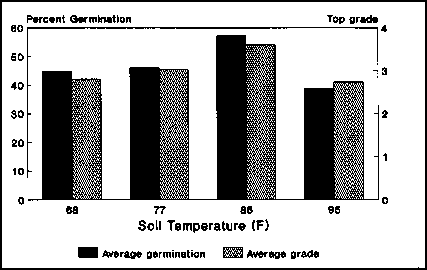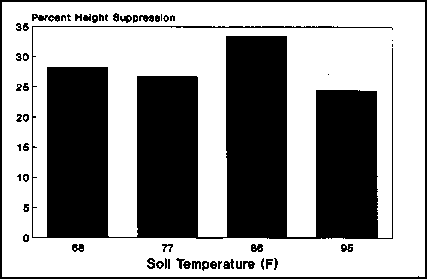
Effect of Temperature and Daminozide on Germination and Growth of China Doll Seedlings
Return to: MREC Home Page
Return to: MREC Research Index
A. R. Chase,Ph.D., C. A. Robinson and C. A. Conover, Ph.D.*
University of Florida/IFAS
Central Florida Research and Education Center
CFREC-Apopka Research Report RH-94-1
Introduction
China Doll, Radermachera sinica, is an evergreen tree that was introduced from southeast Asia for use as an indoor houseplant. It is sometimes called Radermachera or Radar plant, but China Doll appears to be the name most commonly used in the foliage industry. China Doll grows rapidly and becomes leggy and unsalable unless treated with growth regulators. Several research reports have been published since 1986 regarding growth of China Doll as affected by temperature and fertilizer level (1, 2, 3). In 1990, Wang and Dunlap reported on the effect of ethylene on leaf abscission of China Doll (4). Very little other written information is available about producing this crop.
In late 1992, a research project was started to evaluate growth of China Doll under different temperature conditions to determine the potential for an interaction between temperature and the growth regulator, daminozide. Seeds were obtained from a local producer and planted at a rate of 100 per 6 inch standard pot containing Vergro potting medium. They were placed in temperature control chambers which were set to soil temperatures of 68, 77, 86, or 95°F. Twelve pots per temperature were used. Percent germination was determined weekly for 1 month, and at the end of the test period, pots were evaluated for overall appearance which took into account seedling density and size as well as color. This test was performed three times between November 1992 and August 1993.
A second series of experiments was performed using seedlings from a commercial producer. Plants were about 3 inches tall and had not been treated with any growth regulators. They were planted in 6 inch standard pots again containing Vergro and top-dressed with 5 g of Sierra 19:6:12 slow release fertilizer at test initiation. Soil temperatures were the same as those described above and again used 12 pots per temperature. Half of the pots in each temperature were treated with daminozide at the recommended rate (1 g/360 ml water) by spraying them to runoff. Plant height was determined after one month and percent difference in height of watertreated controls and daminozide-treated plants at each temperature was calculated. This test was performed three times between December 1992 and July 1993.
Results
Soil temperature significantly affected both germination percentage and overall top grade of the China Doll seedlings in all three tests (Fig. 1). Best germination and top grade were consistently found in pots with a soil temperature maintained at 86°F. Plants in these pots were more vigorous, had better green color and as a result had best top grades. Plants produced at the other three temperatures had poorer germination and were of lower quality; with those growth at 95°F lowest in all three tests.
Height was significantly affected by both soil temperature and daminozide treatment with greatest height suppression occurring at 86°F (Fig. 2). There was a significant interaction between soil temperature and daminozide treatment on plant height in only one of the three tests (Table 1). Daminozide suppressed height at all temperatures from about 24 to 34%. The percent height suppression was similar regardless of time of year although plants grew tallest in the test conducted during the spring (Test 2). Plants produced at 95°F were consistently shorter than those in the other three temperatures.
Conclusions
Soil temperature can significantly affect germination and growth of China Doll seedlings. Optimal germination and growth occurred with a soil temperature of 86°F. During the spring, plants may grow too rapidly and become unsalable necessitating applications of growth regulators such as daminozide. The percent of height reduction which was achieved with the daminozide treatment was consistent regardless of time of year in our tests, making adjustments in rate of application apparently unnecessary. It is clear that a production schedule for China Doll seedlings must take temperature into account since the plants grew twice as fast during the spring test as they did during the winter or summer tests.
*Professor of Plant Pathology, Biological Scientist, and Professor of Environmental Horticulture and Center Director (retired 7/96), Central Florida Research and Education Center - Apopka, 2807 Binion Road, Apopka, FL 32703-8504, respectively.
Literature Cited
- Chase, A. R. and R. T. Poole. 1989. Nutrition of Radermachera sinica. CFREC-Apopka Research Report RH-89-10.
- Poole, R. T., A. R. Chase and L. S. Osborne. 1991. China Doll. CFREC-A Foliage Plant Research Note RH-91-11.
- Poole, R. T. and C. A. Conover. 1986. Response of foliage plants to minimum temperatures and fertilizer levels. AREC-Apopka Research Report RH-86-18.
- Wang, Yin-Tung and J. R. Dunlap. 1990. Leaf abscission in Radermachera sinica in response to ethylene and silver thiosulfate. HortScience 25(2):233.
Table 1. Effect of soil temperature and daminozide treatment on height of China Doll seedlings in three tests.
| Temperature | Growth Regulator | Mean plant height (in) | ||
|---|---|---|---|---|
| Test 1 21 January 1993 |
Test 2 5 May 1993 |
Test 3 21 July 1993 |
||
| 68°F | water | 10.0 | 14.1 | 10.2 |
| daminozide | 7.2 | 10.6 | 7.0 | |
| 77°F | water | 8.9 | 17.4 | 11.5 |
| daminozide | 7.7 | 11.2 | 8.0 | |
| 86°F | water | 9.4 | 16.0 | 10.3 |
| daminozide | 6.9 | 10.7 | 6.1 | |
| 95°F | water | 7.7 | 12.6 | 9.9 |
| daminozide | 6.4 | 9.9 | 6.5 | |
| Significancez | ||||
| Temperature (T) | ** | ** | * | |
| Growth Regulator(G) | ** | ** | ** | |
| T x G | ns | ** | ns | |
zSignificance is denoted as ns = not significant, * = significant at the 5 % level, ** = significant at the 1% level.
Figure 1. Effect of soil temperature on germination and top grade of China Doll seedlings. Top grade was Erated on a scale from 1 (dead) to 5 (excellent. Data presented are the mean of three tests.

Figure 2. Effect of soil temperature on percent height suppression for China Doll treated with daminozide. Data presented are the mean of three tests.
